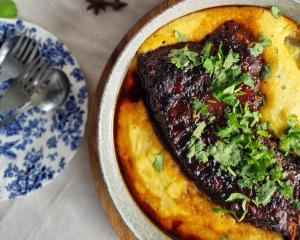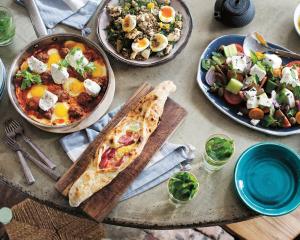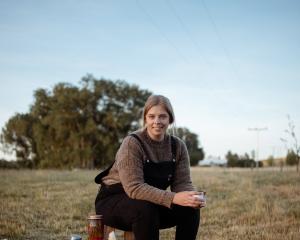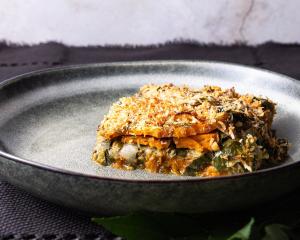
The 46-year-old's cooking and travel programmes, which are shown in New Zealand, include Gino’s Italian Escape. His new cookbook, Gino’s Italy: Like Mamma Used to Make, has an accompanying television series.
When were you happiest?
I am always very happy in Sardinia with my family; I spend at least six months of the year there. Six months working and six months relaxing - I think that is a great balance.
What is your greatest fear?
Overcooking pasta for my Italian family in Napoli - they would kill me.
What is your most treasured possession?
My little principessa Mia - please do not tell my two boys!
Describe yourself in three words
Fair, focused and loyal.
What makes you unhappy?
Overcomplicated, pretentious, boring food. Sometimes it is better to keep recipes simple using great ingredients.
Who would play you in the film of your life?
I’d like to think Leonardo DiCaprio, but I would settle for Brad Pitt.
What scares you about getting older?
Nothing. There is a region in Sardinia called the ‘‘blue zone’’ where some of the oldest people in the world live. They exercise every day, drink wine and eat great food. What is to fear?
Which words or phrases do you most overuse?
Fantastico.
Which book are you ashamed not to have read?
I have never read a book - I’ve tried many times, but I just fall asleep.
What did you want to be when you were growing up?
I wanted to be a footballer at first, like any other Neapolitan kid.
Would you choose fame or anonymity?
Sometimes anonymity sounds great, but I consider myself lucky and don’t like it when famous people complain about fame.
What is your guiltiest pleasure?
A cold beer watching Only Fools and Horses.
What or who is the greatest love of your life?
My wife, Jessica - the only woman crazy enough to choose to spend the rest of her life with me. We met when I was 18; now that is commitment.
What has been your biggest disappointment?
That Italy didn’t qualify for the World Cup last year.
If you could edit your past, what would you change?
I would have spent more time with my parents. I did see them often, but you don’t realise how much you’ll miss someone or something until it’s gone.
When’s the last time you changed your mind about something significant?
I often change my mind when I chat with my children. They bring a more modern perspective on things.
How would you like to be remembered?
As a nice and fair guy who helped bring authentic Italian cooking to the UK.
What is the most important lesson life has taught you?
Minimum effort, maximum satisfaction. That’s the way everyone should live.
-The Guardian
 Biscoff and espresso cheesecake
Biscoff and espresso cheesecake

This is one of my wife’s favourite desserts.
She is a huge cheesecake lover and I often catch her dunking one of these biscuits in her coffee, so I decided to come up with something that would combine both.
I have used a strong coffee liqueur in this recipe, but it also works really well with Irish cream liqueur.
You can make a chocolate cheesecake by using chocolate-hazelnut spread instead of Biscoff spread, or substitute the Biscoff biscuits for digestives.
This is an amazing cheesecake recipe that you can really get creative with.
Serves 10-12
250g Lotus Biscoff biscuits, plus three biscuits for decoration
100g salted butter, melted
300ml double cream
80g icing sugar
500g full-fat cream cheese
2 tsp vanilla extract
20ml strong espresso coffee
10ml coffee liqueur, such as Kahlua
150g Biscoff spread
For the coffee syrup
50ml strong espresso coffee
50ml coffee liqueur, such as Kahlua
50ml caster sugar
Method
Crush the biscuits by using either a food processor or putting them in a sealed food bag and, using a cooking hammer or rolling pin, smashing them until you get crumbs. Tip them in a medium-sized bowl with the melted butter and, using a flexible spatula, mix well, ensuring the butter has coated all the crumbs.
Pour into a loose-based cake tin - I use a deep tin with a diameter of 24cm and a depth of 6cm - and press firmly over the base and sides, ensuring the sides are even (that is the part you will see when the cheesecake is finished). Place in the freezer while you prepare the filling.
Pour the cream and icing sugar in a large bowl and whip until soft peaks form.
In a separate large bowl, whisk the cream cheese and vanilla extract until smooth. Pour the whipped cream into the cream cheese mixture and use a spatula to mix.
Pour half the cream cheese filling in another large bowl. Add the coffee and liqueur to one bowl and use a spatula to mix gently until smooth in colour. Remove the biscuit base from the freezer and pour over the coffee cream mixture. Spread evenly using a spatula and return to the freezer for 10 minutes.
Place the Biscoff spread in the remaining cream cheese mixture and use a spatula to mix well, again until smooth in colour. Remove the biscuit base from the freezer and gently spread on top of the coffee cream mixture, creating a two-layer cheesecake. The layers are very similar in colour, but the balance of flavours is perfect. Smooth the top and place in the fridge for at least five hours, allowing the cheesecake to set.
To make the syrup, pour all the ingredients into a small saucepan and place over a medium heat. When bubbling, reduce the heat and simmer for about six minutes, creating a runny thick syrup, stirring occasionally with a wooden spoon.
You can test it is ready by making sure it coats the back of a metal spoon. Pour into a small jug and allow to cool completely.
When ready to serve the cheesecake, drizzle over the coffee syrup and arrange three biscuits standing up in the centre.
This will be okay to eat for three days if kept, covered, in the fridge, provided it lasts that long.
 Grilled vegetable salad with lemon and mustard dressing
Grilled vegetable salad with lemon and mustard dressing

This is one of my favourite salads of all time. For me, it’s a real combination of Italy and the UK. The grilled vegetables and artichokes, which we eat almost daily in the South of Italy, mixed with avocado, honey and mustard are a perfect match.
This really is a meal in itself, but you can add tuna, feta or even pieces of cooked chicken if you prefer. If you’re preparing this in advance, don’t add the avocado, dressing or lemon until ready to serve, or it will discolour the salad.
Serves 2 as a light lunch
1 Little Gem lettuce
2 courgettes, 1cm trimmed off each end, halved horizontally, then finely sliced lengthways
1 red capsicum, deseeded and cut into three
2 Tbsp olive oil
280g chargrilled artichokes in oil, sliced, oil reserved
10 mint leaves, finely sliced
1 tsp grainy mustard
2 Tbsp white wine vinegar
1½ tsp runny honey
1 large avocado
juice of ½ lemon
salt and freshly ground
black pepper
Method
Heat the oven grill.
Separate the leaves from the lettuce, roughly tear them in half and place on a serving platter, creating a bed. Set aside.
Cover a large baking sheet with foil. Place the courgette slices on the sheet. Put the capsicum pieces, skin side up, on the same sheet if you have room (if not, grill the vegetables in batches). Brush the capsicum and courgettes with olive oil and season with a pinch of salt and pepper. Turn the courgettes over and brush with the remaining olive oil and sprinkle over a small pinch of salt and pepper. Place under the grill for seven minutes.
Remove from the oven, turn over the courgettes and grill for a further five minutes, until the courgettes are golden and the capsicum are black.
Remove the baking sheet from the oven and place the capsicum in a small bowl. Cover with clingfilm and set aside to cool. Place the courgettes on top of the prepared lettuce leaves.
Pour the artichokes and their oil into a bowl. Remove the artichokes and scatter them over the courgettes and lettuce. Once the capsicum has cooled, peel and discard the skin, finely slice and add to the salad.
Sprinkle half the mint leaves into the bowl of artichoke oil. Add the mustard, vinegar and honey and mix well. Peel and pit the avocado and finely slice. Place in the bowl and gently toss together.
When ready to serve, place the avocado slices on top of the salad, drizzle over the dressing and the lemon juice and sprinkle over the remaining mint.
Season with 4-5 twists of pepper and serve with some simple toasted ciabatta bread, rubbed with a garlic clove.
I could literally eat this every day. Enjoy!
 Slow-cooked pork shoulder with super-crispy crackling
Slow-cooked pork shoulder with super-crispy crackling

I am very lucky that I get to spend at least four months of the year in Sardinia. The people there are huge pork lovers and it features on nearly every menu. Rather than spit-roasting the pork, which is their speciality, I wanted to create a slow-cooked pork that still had the amazing crunchy crackling we all love.
You can marinate the meat the night before and literally all you have to do is put it in the oven. Minutes to prepare and four and a-half hours to cook, but no actual time taken away from your day. Perfect for lazy Sundays.
In the D’Acampo household, we serve this with brioche buns and coleslaw, but anything goes, from crispy salad to roast potatoes to simple boiled rice. I promise, this will be the best pork you have ever made, however you decide to serve it!
Serves 6-8
2.2kg pork shoulder, with skin on (ask your butcher to score the skin)
2 large onions, halved horizontally
3 large carrots
5 rosemary sprigs
200ml red wine
200ml water
1 tsp cornflour
sea salt flakes
For the dry rub
1 Tbsp garlic powder
1 Tbsp smoked paprika
2 tsp English mustard powder
1 tsp ground turmeric
2 tsp vegetable stock powder
salt and freshly ground
black pepper
For the glaze
3 Tbsp barbecue sauce
3 Tbsp honey
1 Tbsp dark soy sauce
1 tsp chilli powder
Method
Place a sheet of baking paper on a baking tray. With a sharp knife, separate the skin from the pork and set aside. Trim and discard any excess fat around the meat.
Place all the dry rub ingredients in a large baking tray with half a tablespoon each of salt and pepper and use your fingertips to mix well. Take the pork skin and put it in the mixture, making sure it is completely covered on both sides. Place it on the baking paper, skin up, cover and put in the fridge for at least 2 hours. Now put the pork shoulder in the mixture and cover it completely with the dry spices, ensuring the meat is coated on all sides, including all the little crevices. You should have used up all the dry rub, leaving a clean baking tray. Set the pork aside on a plate.
Arrange the onions, carrots and rosemary in the baking tray where the spices were, creating a natural rack for the meat to sit on. Place the pork shoulder on top. Add the wine and measured water at the sides of the tray to make sure the meat stays dry. Cover with foil, making sure the tray is sealed completely, and rest in the fridge for at least two hours.
Heat the oven to 170degC/fan 150degC. Place pork in the bottom of the oven and cook for two and a-half hours. Take the skin out of the fridge. Generously sprinkle over 2-3 pinches of sea salt flakes and place in the top of the oven. Cook the pork and skin for another one and a-half hours.
For the glaze, pour the ingredients into a small bowl. Mix well.
Remove the crackling from the oven and drain excess fat. Remove the pork shoulder from the oven. Remove and discard the foil and, using a pastry brush, coat the pork shoulder with the glaze.
Increase the oven temperature to 220degC/fan 200degC and place the crackling back on the top shelf and the shoulder on the bottom. Cook for a final 30 minutes.
Remove the crackling from the oven and place two forks or spoons under it, allowing air to circulate around. Set aside. Remove the shoulder from the oven and carefully lift the meat on to a large serving platter. Cover with foil and let it rest.

Drizzle the gravy over the meat.
Finally, chop the crackling into small pieces and sprinkle over the meat.
Serve immediately.
THE BOOK
Gino’s Italy: Just Like Mamma Used To Make, by Gino D’Acampo, published by Bloomsbury, $52.99, photography by Haarala Hamilton.













